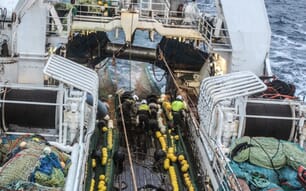The inshore trawlers still only have a small quota for haddock in this area and so these selectivity trials offer a potential solution to this challenge. Seafish's South West regional team, the Seafish Gear Technologist and CEFAS collaborated to put together the project.
The rules of the Landing Obligation, also known as the discard ban, will be fully implemented by 2019, meaning fishermen are having to find ways of avoiding catching more than their quota of, in this instance, haddock.
After several meetings with the local skippers it was decided that using a low headline trawl could help them avoid catching too many haddock while still enabling them to catch their other valuable demersal species such as lemon sole, plaice and cuttlefish.
Seafish's South West regional team, the Seafish Gear Technologist and CEFAS collaborated to put together the project and Clive Palfrey, a local net maker, helped redesign the trawl bringing the top panel of the net even closer to the seabed, to just under 800mm (as haddock tend to swim just off the bottom of the seabed).
With support from the netmaker and skipper, Seafish undertook the gear development and then set up the gear on the vessel. CEFAS assisted, using their expertise in catch sampling and putting together scientific analysis of the results.
The initial testing of the trawl was on the Looe trawler, MFV Swiftsure, with skipper Richard Chapman. Both the vessel's usual net and the new design were filmed using underwater cameras to show how the trawl was performing on the seabed and how fish were reacting to the net.
This fascinating video footage also enabled an accurate measurement of the height of the new trawl to be made. The height was as expected to be in the region of 800mm compared to the skipper's usual trawl standing around 3 metres from the seabed.
One of the design requirements of the new trawl was to have the ability to be towed over the firmer seabeds in the SW with the occasional boulder waiting to tear the net. The net's ability to cope with these obstacles was demonstrated several times with the video footage showing the trawl being towed over various sized boulders.
The video footage produced is poor quality compared to modern HD footage, but this was expected given the water depth and murkiness at this depth, however it is a view of gear at work that very few fishermen ever get the chance to see, and skippers will now be able to study this footage with each viewing revealing something different in the gear.
Mike Montgomerie, Seafish Gear Technologist, said: "By getting the headline so low it has helped demonstrate that it is possible to avoid catching some of the haddock that would normally have to be discarded while still retaining other valuable species. The video footage is important to show how the different species react to the advancing trawl and to take the guess work out of knowing the height of the trawl above the seabed. Further trials will need to be undertaken to assess whether it will be commercially viable for the SW inshore fleet to use a trawl of this design."
The preliminary results were very promising, showing a marked reduction in the catch of haddock without any appreciable loss of other bottom living species. This was vital as a major part of this first sea trial was to ensure that the new net was catching enough bottom living species that the vessel would still be viable despite the loss of some of its haddock catch. The trials will continue throughout the summer.



